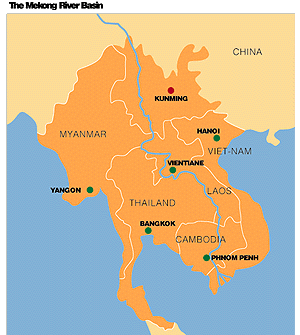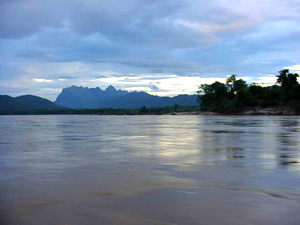 The
The
Along this path, carved out over millennia, the
In effect, the Mekong River Commission (MRC), an inter-governmental body of
It’s strange, but the MRC says this is all necessary and that they have no choice but to exploit the natural resource power of the

At the same time the MRC insists that it supports sustainable development, that it cares deeply about the Mekong basin and, as stated in their mandate, that they will make every effort “To promote and coordinate sustainable management of water and related resources for the countries’ mutual benefit and the people’s well-being” in a manner that is “consistent with the needs to protect, preserve, enhance and manage the environmental and aquatic conditions and maintenance of the ecological balance exceptional to this river basin.”
It certainly sounds like something local, riparian communities and environmental groups can support. However, the reality of the MRC is a far cry from this glowing image of social and environmental heroism.
In fact, it’s often suggested that the MRC must be replaced because out of either fear or inability or just plain old greed, it has created “a vacuum of accountability” that allows developers move forward with their hydro projects “unchallenged,” with little regard to their effect on the Mekong basin or its inhabitants, without even so much as an environmental assessment.
Results and Consequences
Next to the Amazon, the
Each year, between June and December, the
"As the floodwaters recede, the fishermen of the region work together constructing what are, in effect, long bamboo fences around the lake to trap the migrating fish. The fences stretch for some 1,500 km, using 3 million stakes or more. Huge quantities of fish are caught – around 30 tons an hour in one single fishery. Although this is not industrial fishing in the accepted sense, it is artesian fishing on a massive scale and a truly impressive sight," describes the New Agriculturist.
Historically, the communities would get about 80% of their nutritional needs from this annual effort.
Today, such a prospect is impossible. "It is now estimated that the total fish catch from the
More than that, communities say the dominant species have begun to mature at a much younger age, which means, on top of the steep decline in population, the fish are now smaller and less valuable. Some communities say they now have to fish ‘night and day’ – even for weeks on end, to meet the same yield that they would historically gather with ease. Others have been simply forced to abandon their livelihood altogether.
Communities rely on farming to meet the rest of their subsistence needs. However, this too is being threatened by the dams. "The dams’ reservoirs retain a lot of nutrient-rich sediment that would otherwise be spread by [the] annual floods to the lower
This is causing soil throughout the basin to become less fertile, which, on top of affecting the health of the ecosystem, is leaving farmers with no choice but to rely on poisonous chemical fertilizers.
Displacement is another major concern. To date, hydro development has primarily taken place on the upper end of the
It is unclear how many people have been displaced by the upper Mekong dams, however, there is an increasing push to get started on the lower Mekong, particularly where it runs through Laos, which threatens to displace more than 75,000 people, and "condemn millions [more] to serious food shortages and increased poverty," says Chris Lang, an environment researcher based in Frankfurt.
Jeremy Bird, the executive director of the MRC, claims there will be "…tremendous efforts… targeted towards first of all avoiding those impacts."
It’s almost comical, given that Bird says any such effort should not involve those who would be affected the most, the riparian communities.
Bird’s opinion was brought to life in September 2008, when “the MRC organized a meeting in
Drowning the Future
In an industry that drowns in hypocrisy, much like the forest regions and livelihoods it destroys, Mr. Bird’s statements should come as no surprise. The MRC, while presenting itself as a champion of sustainable development, has and will continue to facilitate the destruction of the
After all the name of the game here is power, not the kind we need for light bulbs and cell phone chargers, but that all-corrupting power where, be it through the clench of a fist, the muzzle of a gun, or through scratches on some eco-friendly paper, one can decide the future of countless others.
This desperate situation begs the need for the riparian communities to come together and confront the MRC, the state governments, and the corporations that will force them to bear the full burden of hydro development while benefiting from it the least.
***
You can find more articles by John Schertow at his blog, www.intercontinentalcry.org
Photo of dam from Terreper.org
Map from Mofa.go.jp
